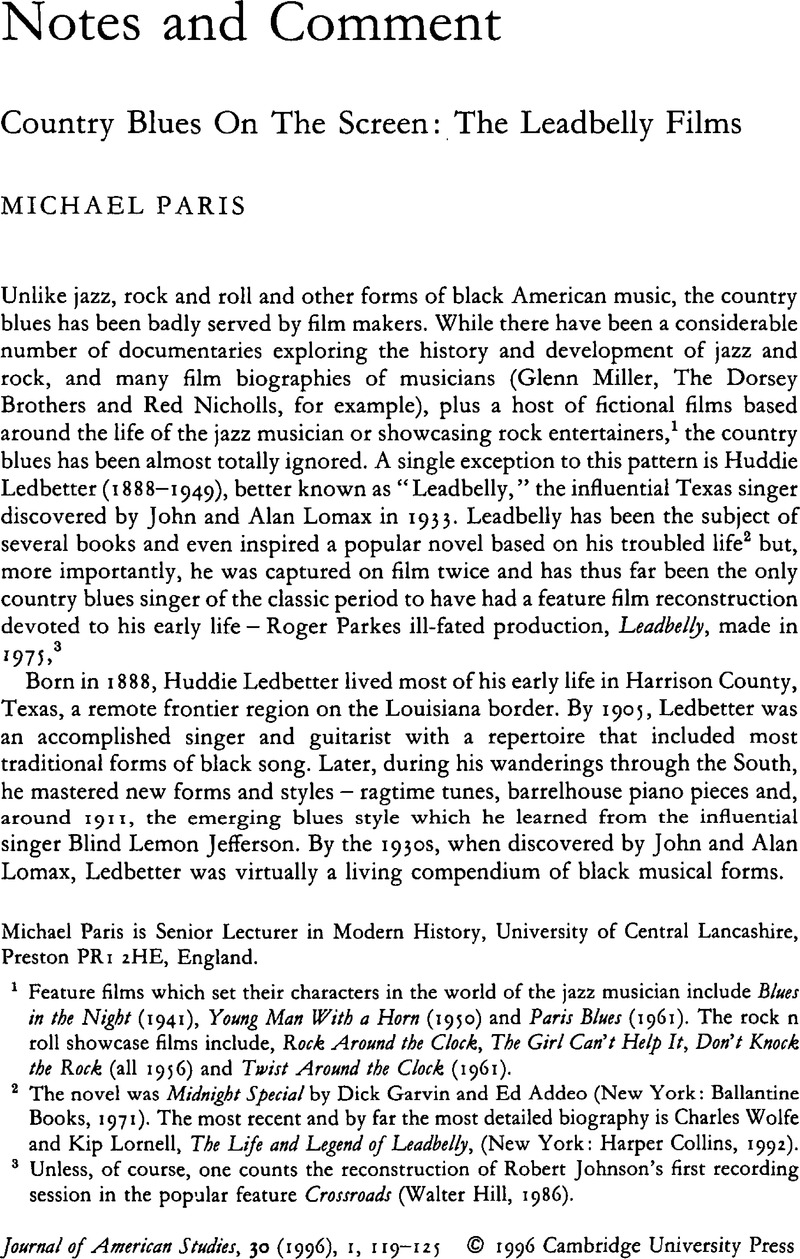No CrossRef data available.
Article contents
Country Blues On The Screen: The Leadbelly Films
Published online by Cambridge University Press: 16 January 2009
Abstract

- Type
- Notes and Comment
- Information
- Copyright
- Copyright © Cambridge University Press 1996
References
1 Feature films which set their characters in the world of the jazz musician include Blues in the Night (1941), Young Man With a Horn (1950) and Paris Blues (1961). The rock n roll showcase films include, Rock Around the Clock, The Girl Can't Help It, Don't Knock the Rock (all 1956) and Twist Around the Clock (1961).
2 The novel was Midnight Special by Garvin, Dick and Addeo, Ed (New York: Ballantine Books, 1971)Google Scholar. The most recent and by far the most detailed biography is Wolfe, Charles and Lornell, Kip, The Life and Legend of Leadbelly, (New York: Harper Collins, 1992)Google Scholar.
3 Unless, of course, one counts the reconstruction of Johnson, Robert's first recording session in the popular feature Crossroads (Walter Hill, 1986)Google Scholar.
4 Wolfe and Lornell, 119–120.
5 Ibid. 81–82.
6 The Herald Tribune, 3 Jan. 1934, for example, ran a long story under the title “ SWEET SINGER OF THE SWAMPLANDS HERE TO DO A FEW TUNES BETWEEN HOMICIDES.” “Lead Belly” (sic) was described as a “powerful, knife-toting Negro” who had killed one man and wounded another but had been pardoned for his “ sweet singing. ”
7 I have quoted from the original film text here. The Leadbelly episode was shown in the Channel 4 series “Dust and Dreams,” (1988). A transcription of the text, from blues authority Herman Gebhard, is quoted in Wolfe and Lornell (pp. 164–166). It should be noted, however, that there are minor discrepancies between this and the original film text. A fragment of the first scene is included in the video A Vision Shared: A Tribute to Woody Guthrie and Leadbelly (see 13 below).
8 Wolfe and Lornell, 163.
9 Capital T 1821 (recorded 1944).
10 Pete Seeger quoted in Wolfe and Lornell, 235. The edited film was released commercially in 1985 by Film Images as Three Songs by Leadbelly.
11 Filene, Benjamin, “‘Our Singing Country’: John and Alan Lomax, Leadbelly, and the Construction of an American Past,” American Quarterly, 43: 4 (12 1991), 604CrossRefGoogle Scholar.
12 Wolfe and Lornell, 257.
13 Both quotations are taken from the film A Vision Shared: A Tribute to Woody Guthrie and Leadbelly, Ginger Group for CBS Music Video, (1988).
14 Monaco, James, American Film Now (New York: New American Library, 1979), 198Google Scholar.
15 In the United Kingdom the film has received only limited showing on satellite television and has not yet been released on video.
16 The full story of the film's troubled history is related in Wolfe and Lornell, 260–262, and Monaco, 197–199.


